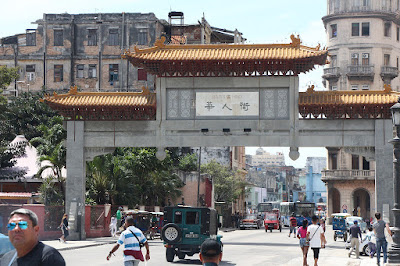Havana is
composed of neighborhoods and districts.
The “new city” is home to Revolution square which is surrounded by
government offices. The square itself is
huge and is the site of major speeches by government luminaries.
Fidel once gave a speech there that was seven
hours thirty minutes long. He was well
known for giving long speeches and gave the longest speech ever given at the
United Nations, four hours twenty-nine minutes.
Then, there
is Chinatown where street signs are written in Chinese and Spanish.
In the 1850s, slavery throughout the European
world was in decline and created a labor shortage in the Cuban sugarcane
fields. This was serious since Cuba’s
economy was almost entirely dependent on sugar.
Needing laborers to work the fields, Spain looked to China where cheap
labor was found. Many Chinese were hired
into indentured servitude or, sometimes tricked into de facto slavery. By the 1870s there were 40,000 Chinese in
Cuba. Many of them intermarried with the local population.
However, miscegenation laws prohibited marriage to Spaniards. Today, there are no Chinese left in Chinatown
and only one Chinese restaurant remains.
The Malecón
which runs along the waterfront provides fishing opportunities for the city’s
residents. It’s a broad esplanade that
stretches for 8 km along Havana Bay. It
is a popular promenade with businesses, restaurants and street entertainment.
Like big
cities throughout history, la Habana has its poor sections. Poorly maintained buildings are found in
nearly every section of town but are much more common in certain areas. Residents in one rundown neighborhood decided
to beautify their street and La Callejon (little street) Hamel is the
result.
Buildings on both sides of the
tiny street are covered with colorful murals from rooftop to the sidewalk. Whimsical sculptures crafted from recycled
materials line the streets. Benches are
made from old bath tubs cut in half length wise.
Okay, so these next two sculptures were not found in the Callejon de Hamel, but they are interesting and we found sculpture to be a very popular medium everywhere we went.
Most Cubans
are Catholic and churches are common but there is a small population of Muslims
that maintains a tiny mosque in the old city.
One could
easily spend a week in the city and not see all it has to offer.















No comments:
Post a Comment